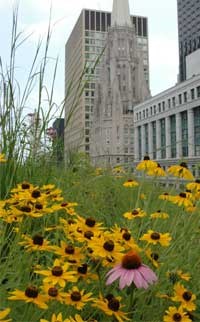Last updated: February 23, 2023
Article
Green Roofs on Historic Buildings: Summary and Resources

Courtesy of the City of Chicago
Summary
Currently there are no comprehensive national standards or guidelines for green roofs, however, design guidelines approved by the American National Standards Institute (ANSI) have been developed for fire, wind uplift and root repellency of green roof systems. Some municipalities include green roofs in building codes as they relate to stormwater management, and some have created incentives for their use. North America is somewhat behind Europe, specifically Germany, in the movement to install green roofs. The most comprehensive information available about green roofs was developed in Germany by the Landscape Research, Development, and Construction Society, known by its German initials FLL (for Forschungsgesellschaft Landschaftsentwicklung Landschaftsbau).
While the popularity of green roofs in Canada and the United States continues to increase, their relative scarcity may be due to the lack of data on their performance, higher initial cost than traditional roofs, and a scarcity of professional expertise available for their design. North America has a wider climatic range which makes it more difficult to apply lessons learned from one area on to another. One organization, Green Roofs for Healthy Cities (GRHC), is working to increase the number of knowledgeable professionals. The Green Roof Professional (GRP) accreditation program was created by GRHC in 2004, to create a body of professionals versed in the design, installation, and maintenance of green roofs.
Incentives by cities such as Washington, DC, Portland, OR, Chicago, IL, Philadelphia, PA, and Toronto, Ontario, as well as codes such as the International Green Construction Code (IgCC) and certification programs such as the United States Green Building Council’s (USGBC) Leadership in Energy and Environmental Design (LEED) program, are gradually encouraging more developers and owners to include green roofs in their projects.
Resources
Bass, Brad and Bas Baskaran. Evaluating Rooftop and Vertical Gardens as an Adaptation Strategy for Urban Areas. Research report prepared for National Research Council Canada. 2003.
Peck, Steven W., Chris Callaghan, Monica E. Kuhn, and Brad Bass. Greenbacks from Green Roofs: Forging a New Industry in Canada, Status Report on Benefits, Barriers and Opportunities for Green Roof and Vertical Garden Technology Diffusion. Research report for Canada Mortgage and Housing Corporation (CMHC). March 1999.
Pennsylvania State University Center for Green Roof Research
Rosenzweig, Cynthia, Stuart Gaffin, and Lily Parshall (Eds). Green Roofs in the New York Metropolitan Region: Research Report. Columbia University Center for Climate Systems Research and NASA Goddard Institute for Space Studies. New York, 2006.
Snodgrass, Edmund C. and Linda McIntyre. The Green Roof Manual, a Professional Guide to Design, Installation, and Maintenance. Portland: Timber Press, 2010.
U.S. Department of Energy, Energy Efficiency and Renewable Energy, Building Technologies Program. Guidelines for Selecting Cool Roofs. Brian Urban and Kurt Roth, Ph.D. DE–AC05–00OR22725. July 2010.
U.S. Department of Energy, Energy Efficiency and Renewable Energy, Federal Energy Management Program. Federal Technology Alert, Green Roofs. DOE/EE–0298. September 2004.
U.S. Environmental Protection Agency, Climate Protection Partnership Division, Office of Atmospheric Programs. Reducing Urban Heat Islands: Compendium of Strategies. Eva Wong, Kathleen Hogan, Julie Rosenberg and Andrea Denny. 2008.
U.S. Environmental Protection Agency. Heat Islands.
U.S. Environmental Protection Agency, Office of Research and Development, National Risk Management Research Laboratory, Water Supply and Water Resources Division. Green Roofs for Stormwater Runoff Control. Robert D. Berghage, David Beattie, Albert R. Jarrett, Christine Thuring, Farzaneh Razaeik, and Thomas P. O’Connor. EPA/600/R–09/026. Cincinnati, OH, February 2009.
